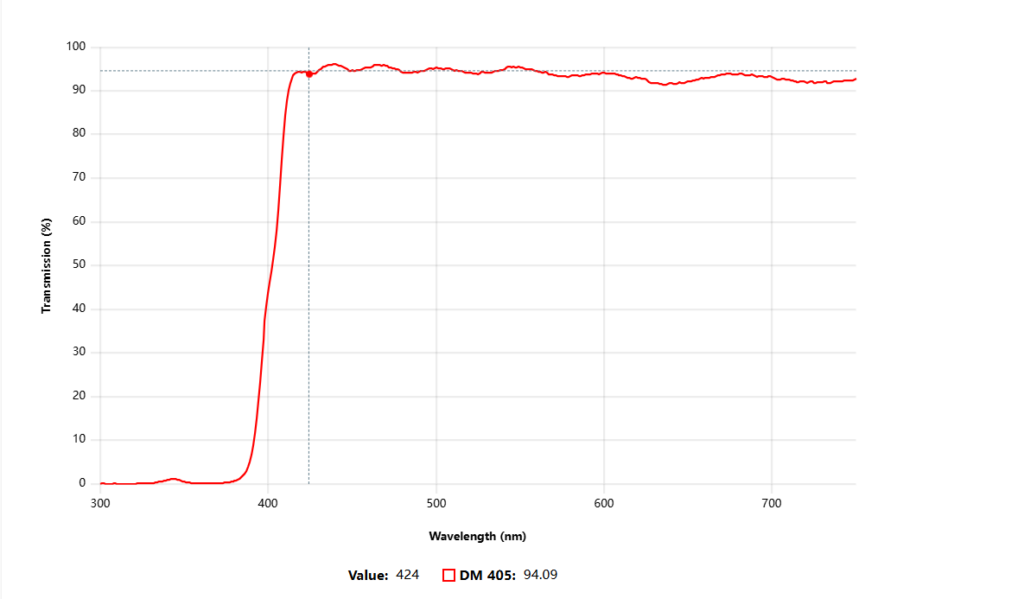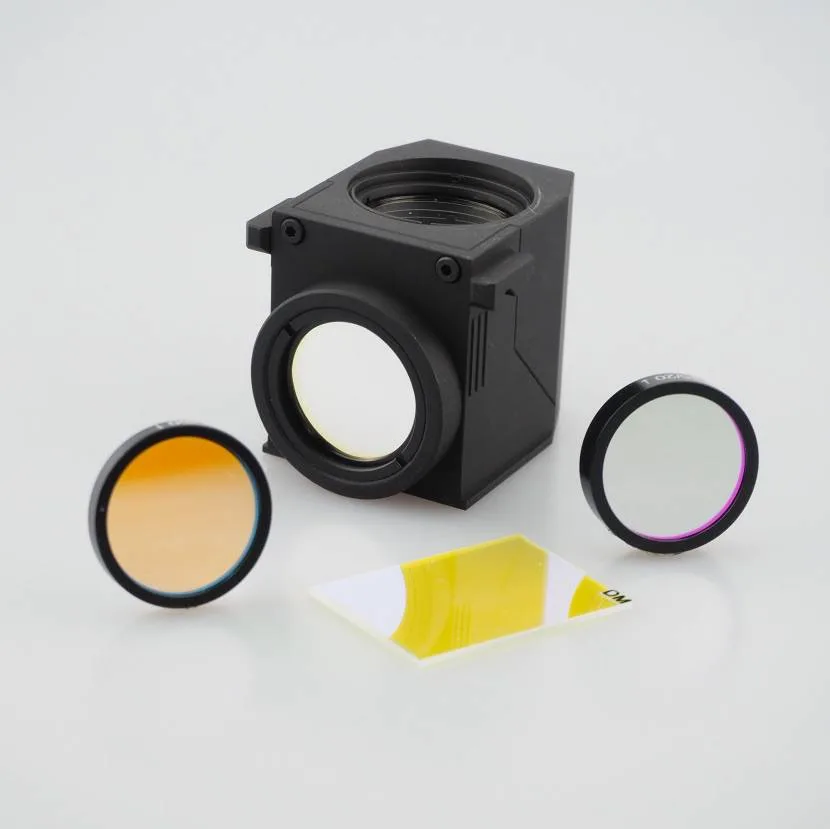Dichroic mirrors are important optical components used in fields such as fluorescence microscopy, telecommunications, and laser systems. These mirrors utilize multiple layers of interference coatings to selectively reflect and transmit specific wavelengths of light to increase efficiency.
In this blog post, we will learn about the reflection and transmission efficiency of dichroic mirrors and their importance in optimizing the performance of optical applications.
What Is a Dichroic Mirror?

Also known as interference filters or beamsplitters, dichroics work on the principle of wavelength selectivity. Unlike conventional mirrors, dichroics can separate light by transmitting certain wavelengths and reflecting others.
Dichroics are carefully designed and coated with thin film coatings to form interference patterns, playing an important role in color separation, image enhancement, and laser optics.
Key properties:
- Angular dependence: varies depending on the angle of incidence.
- Spectral range: covers visible, ultraviolet (UV), and near-infrared (NIR) wavelengths.
Basic Function and Composition of Dichroic Mirrors
Dichroic mirrors consist of alternating layers of materials such as silicon dioxide (SiO₂) and titanium dioxide (TiO₂). The thickness of these layers is carefully calculated to achieve constructive or destructive interference, making the mirror extremely efficient at specific wavelengths.
Typical layer thickness: between 100 nm and 500 nm per layer, depending on the wavelength range.
Substrate materials: Fused quartz and BK7 glass, selected for their high optical transparency and low thermal expansion.
Reflection and Transmission Efficiency Explained

1. Reflection Efficiency
Reflection efficiency measures the percentage of light reflected within a specified wavelength range. Most high-quality dichroic mirrors have a reflection efficiency of over 90% for target wavelengths.
Data Point: In fluorescence microscopy, dichroic mirrors achieve up to 98% reflectivity at excitation wavelengths between 450 nm and 550 nm, which is critical for signal fidelity.
Example: A mirror designed for 532 nm (green) laser application may reflect over 95% of that wavelength, but transmit over 90% of wavelengths outside the specified spectrum.
2. Transmission Efficiency
Transmission efficiency quantifies the fraction of non-target wavelengths allowed through. It is typically between 85% and 95%, depending on the spectral region.
Performance metric: A mirror optimized for visible light may have a transmission efficiency of over 92% for wavelengths outside the reflection band.
Effect of Angle of Incident
The angle of incidence of light affects reflection and transmission efficiency. Most dichroics are optimized for a 45° angle, but deviations can cause the wavelength cutoff to shift.
- Efficiency Change: A change from 45° to 30° results in a 5% decrease in reflection efficiency and a change in cutoff wavelength of approximately 20 nm.
- Polarization Sensitivity: For linearly polarized light, the reflectivity can vary by up to 10% between the s- and p-polarization components.
For Precision Applications
1. Fluorescence Microscopy
Efficiency Data: To maximize the signal-to-noise ratio, the mirror used must reflect at least 95% of the excitation light while transmitting more than 90% of the emission wavelength.
Real World Example: A microscope setup using a dichroic mirror for 488 nm excitation can observe fluorescence signals in the 520 nm to 700 nm range with minimal background interference.
2. Laser Optics
High-energy laser systems often use dichroic mirrors to combine beams or precisely route beams. The efficiency of these setups is critical, as even a 1% power loss can severely impact performance for high-precision tasks.
Data Point: In a dual-laser setup, a dichroic mirror might reflect 1064 nm with 99% efficiency while transmitting 808 nm light with 90% efficiency.
Performance Tests and Data
1. Spectral Range and Test Results
Testing ensures that dichroic mirrors meet design specifications. Reflectance and transmittance are measured using an advanced spectrophotometer.
Measurement Accuracy: The measurement error of the spectrophotometer is typically within 0.1%.
Edge Steepness: The mirrors can achieve edge transitions of less than 10 nanometers, which is critical for applications that require clear spectral separation.
2. Thermal and Environmental Stability
To verify durability, mirrors undergo environmental testing that simulates real-world environmental conditions. High-quality coatings resist degradation from prolonged UV exposure and temperature fluctuations.
Durability Test Results: The reflectance of the mirrors dropped to less than 1% after 1,000 hours of UV exposure.
What Factors Affect the Efficiency of a Dichroic Mirror?
Efficiency is affected by the material and thickness of the thin film coating, wavelength range, and angle of incidence.
- Thin film coating material and thickness: The material choice and thickness of the coating determine the interference effect of light, which directly affects the efficiency of reflection and transmission. Optimizing the coating structure can significantly improve performance.
- Wavelength range: Dichroic mirrors are usually designed for a specific wavelength range and can only achieve optimal performance within these ranges. If the wavelength used deviates from the design range, the efficiency will drop significantly.
- Incident angle: Mirrors are usually designed for a specific incident angle (such as 45 degrees). When light is incident at different angles, the reflection and transmission characteristics of the mirror will change, resulting in reduced efficiency.
Conclusion
The reflection and transmission efficiency of a dichroic mirror is determined by precise design and high-quality coatings. Dichroic mirrors like OPTOLONG reflect light with an efficiency of 98% and transmit light with an efficiency of more than 90%.
These values are invaluable in optics-based technologies. Detailed performance specifications and rigorous testing ensure that these components meet the needs of advanced applications from microscopy to laser optics.
FAQ
How Does Dichroic Mirror?
Dichroic mirrors work by using optical thin-film coatings to selectively reflect and transmit light based on wavelength. The mirror’s surface is coated with multiple layers of dielectric materials that create constructive or destructive interference at specific wavelengths.
When light strikes a dichroic mirror, certain wavelengths are reflected while others pass through, depending on the design of the coating. This selective behavior allows dichroic mirrors to effectively separate or combine different wavelengths of light.
Related reading: How Dichroic Mirrors Split Light?
